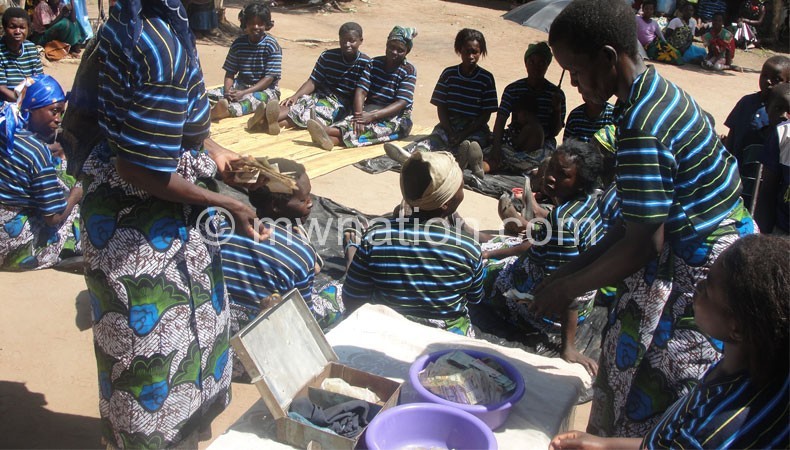Scramble for village banks
Bankers Association of Malawi (BAM)says the move by commercial banks to tap into village banks will help create a more inclusive financial system which is critical to the development of the country’s economy.
BAM, an umbrella body of all the country’s commercial banks, holds the view that the intervention will bring in the cash that is outside the banking system to be used in the economy.

On the part of the banks, BAM chief executive officer Lyness Nkungula says the uptake of customers will obviously move towards increasing financial inclusion.
She says this is a call for the Village Savings and Loan (VSL) groups, populary known as BankiNkhonde, have security for their savings while increasing the banked population.
Nkungula says: “Formalising VSLs will protect consumers from exploitation, and if the product is well managed, the risks could be very minimal.

“The purpose is not to wipe out the village banks, but to work hand in hand. There are insecurity issues surrounding village banks and banks are the safest custodians of the depositors money.”
Through the partnersdhip with banks, every time they want to access their monies, banks will be ready to help out.
“The arrangement would be the same but this time around the three signatories will be the ones to take the money. It is actually easier to lend to groups than to individuals because of transaction costs,” she says.
Ironically, a recent Integrated Household Survey (HIS) by the National Statistical Office (NSO) showed that village banks are gradually becoming the main source of borrowing for households across the country.
NSO figures show that about 42.1 percent of the households borrow from village banks while 15.1 percent borrow from relatives, 12.7 percent from neighbours, nine percent from loan sharks (katapila) and 6.1 percent from other sources.
Borrowing from employers is fourth from bottom at nine percent while banks are on number five from bottom at 1.5 percent.
Bottom on the list of sources of loans is Mardef (now National Economic Empowerment Fund) which has 0.4 percent seconded by grocery local merchant and employers at 0.7 percent.
Reads the report in part: “Loans obtained from village banks were higher in rural areas [42.9 percent] compared to urban areas [37.9 percent], relatives were a source of credit for 16.3 percent of households in rural areas compared to 8.9 percent in urban areas and borrowing from commercial banks was higher in urban areas [3.7 percent] than 1 percent of rural areas.”
As FinMark Trust observes, a notably large number of women in Malawi participate in VSLs.
Of the 614 491 members of VSLs documented in 2014, 71.6 percent were women.
Thus, it may be that while women do not open bank accounts from the formal financial sector as readily as men do, they still obtain financial services, including credit from VSLs.
The trust says the drive by commercial banks to increase market penetration in the retail market has not yielded intended results, with uptake of commercial bank accounts falling to 1 842 accounts per 10 000 adults in September 2019 compared to 2 113 in the previous year.
Says FinMark Trust in its 2019 Measuring Progress Financial Inclusion in selected Southern African Development Community (Sadc) countries report:“However, there are more mobile money accounts per 10 000 adults sitting at 7 840 in September 2019 compared to 6 461 the previous year.
“For commercial bank customers, there has been a four percent point increase in the number of dormant [six months] accounts, which, as of September 2019, was 37.7 percent of total accounts.”
Market analyst Cosmas Chigwe observes that people don’t go to the banks because of the conditions for one to access loans, observing that at an average of 22 percent for consumer loans and four percent on savings, bank rates are cheaper.
He says: “In fact commercial bank rates are far cheaper than VSLs rates. It is the conditions that bank attach such as collateral and high account turnover history.
“On the other hand, village banks also sort of cut out the middleman, in this case banks, when it comes to saving and borrowing. They, therefore, get all the profits which banks would have made through the margin between lending and savings rates.”
Chigwe says in this case, commercial banks’ interests here are not to compete or steal anything from the village banks but rather, they are competing against each other so that the majority of the VSLs groups join them.
“For them, all they want are the group deposits. That’s why all these products are sprouting up,” he says.
Lately, commercial banks in the country have been seen flocking to village banks by introducing services and products designed for them.
This far, FDH Bank plc, National Bank of Malawi plc, Standard plc and NBS Bank plchave introduced accounts tailored for village banks.
Joyce Mkata, chairperson for Umodzi VSL Group in Blantyre, says while they find it strange that banks are suddenly scrambling for village banks, most VSLs have been relying on banks for deposits.
She observes that for 10 years, her group has not made any transactions with the bank where their account is held, except for deposits and withdraws.
“We are yet to see as this is a new concept,” Mkata says.
On his part, consumer rights activist John Kapito says there is need to ensure all Malawians are knowledgeable about all financial transactions they conduct .
Malawi University of Business and Apploed Sciences associate professor Betcheni Tchereni observes that while the scramble by commercial banks shows that there is an opportunity in the village banks, it also shows that commercial banks have not learnt why people decide to transact via village banks.
“It would havebeen better for them to first of all understand why people run away from commercial banks. Generally, saving interest rates are a mockery in Malawi. They are so small that people decide to invest informally,” he says.
Meanwhile, Reserve Bank of Malawi (RBM) says it has no policy regulating village banks in the country.
RBM spokesperson Onilie Nkuna says this is despite the registrar being cognisant of the existence and mushrooming of the village banks.
The development comes on the back of the financial regulator’s plans to introduce community banks, which it said will be restricted on deposit mobilisation and lending to specific locations, among other regulations.
According to RBM, the community banks will be restricted on deposit mobilisation and lending to their specific locations, among other regulations.





